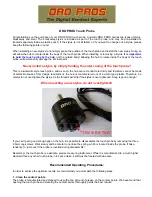
This appliance is Class II and is designed for
connection to a power supply matching that
detailed on the rating label and compatible with
the plug fitted. If an extension lead is required,
use an approved and compatible lead rated for
this appliance. Follow all the instruction sup-
plied with the extension lead.
GUIDELINES FOR USING EXTENSION CORDS
f
Make sure your extension cord is in good condi-
tion. When using an extension cord, be sure to
use one heavy enough to carry the current your
product will draw. An undersized cord will cause
a drop in line voltage resulting in loss of power
and overheating.
f
Always replace a damaged extension cord or
have it repaired by a qualified person before
using it.
f
Protect your extension cords from sharp ob-
jects, excessive heat and damp/wet areas.
f
Use a separate electrical circuit for your tools.
This circuit should be protected with the appro-
priate time-delayed fuse. Before connecting the
motor to the power line, make sure the switch is
in the OFF position and the electric voltage is
rated the same as the voltage stamped on the
motor nameplate. Running at a lower voltage
will damage the motor.
PRODUCT
SPECIFICATIONS
INTENDED USE
The machine is intended for hammer drilling in
concrete, brick and stone. It is likewise suitable
for drilling without impact in wood, metal, ce-
ramic and plastic.
TECHNICAL DATA
Article number
45 332
45 333
Model RH PLUS
2-26
2-26 FC
Rated voltage
V
230
Hz
50
Rated power input
W
850
No-load speed
min
-1
0-1.100
Impact rate
min
-1
0-4.800
Impact energy
J
2,6
Chuck type
SDS PLUS
Weight
kg
2,9
2,9
Sound emission values determined according
to EN 60745-1, EN 60745-2-6
Typically the A-weighted noise levels of the product
are:
Sound pressure
level
dB(A)
91,32
Sound power level
dB(A)
102,32
Uncertainty K
dB
3
Vibration total values a
h
(triax vector sum)
and uncertainty K determined according to EN
60745-1, EN 60745-2-6
Vibration level max:
a
h
m/s
2
14,059
K
m/s
2
1,5
NOISE/VIBRATION INFORMATION
The vibration emission level has been measured
in accordance with a standardized test given in EN
60745-1; it may be used to compare one tool with
another and as a preliminary assessment of expo-
sure to vibration when using the tool for the appli-
cations mentioned.
The vibration emission during actual use of the
power tool can differ from the declared total value
depending on the ways in which the tool is used.
There is the need to identify safety measures to
protect the operator that are based on an estima-
tion of exposure in the actual conditions of use
(taking account of all parts of the operating cycle
such as the times when the tool is switched off and
when it is running idle in addition to the trigger
time).
WARNING!
This machine produces an electro-
magnetic field during operation. This field may
under some circumstances interfere with active or
passive medical implants. To reduce the risk of se-
rious or fatal injury, we recommend persons with
medical implants to consult their physician and the
medical implant manufacturer before operating
this machine.
IDENTIFICATION
1. SDS - plus chuck
2. Tool holder (SDS - plus)
3. Dust protection cap
4. Locking sleeve
5. Depth stop
6. Auxiliary handle
7. Operational mode selection switch
8.
Forward/reverse function lever
9. Lock-on button
10.
On/Off switch
11. Drill chuck
(45333)
BEFORE USE
Be careful of hidden electrical lines or gas and wa-
ter pipes. Check the working area, e.g. with a metal
detector. Always use the correct supply voltage!
The voltage of the power source must agree with
the value given on the nameplate of the machine.
TOOL CHANGING
Take care that the dust protection cap
(3)
is not
damaged when changing tools.
SDS - Plus Tools
The SDS - plus tool is designed to be freely mov-
able. This causes eccentricity when the machine is
offload. How ever, the drill automatically centers
itself during operation. This does not affect drilling
precision.
Inserting
Clean and lightly grease the tool before inserting.
| English
10
RH 2-26 PLUS | RH 2-26 FC PLUS











































